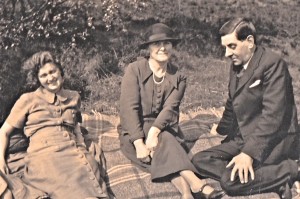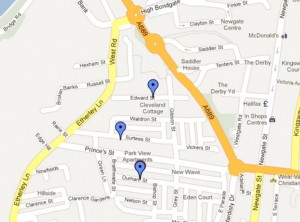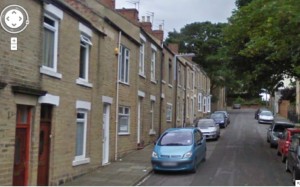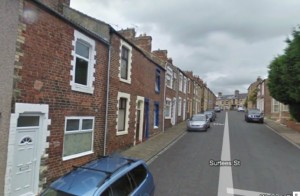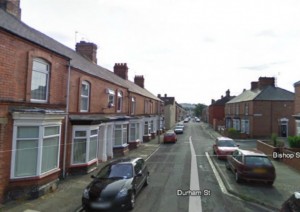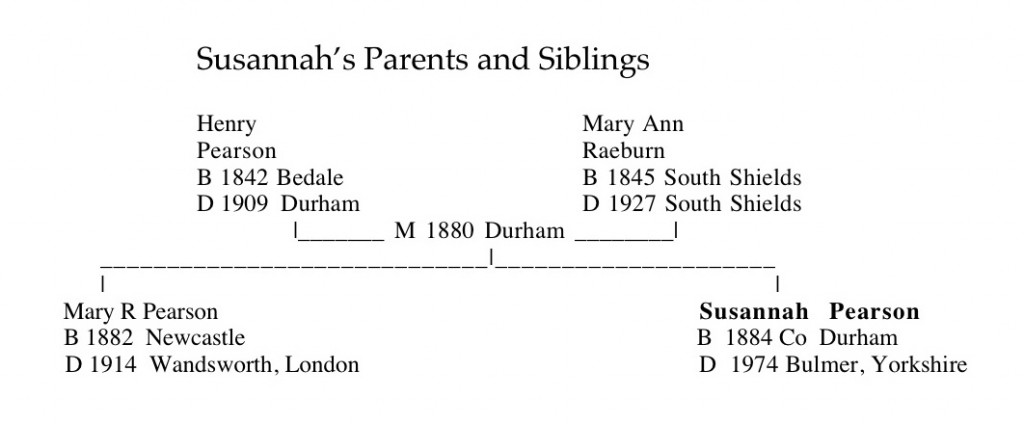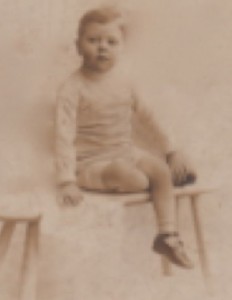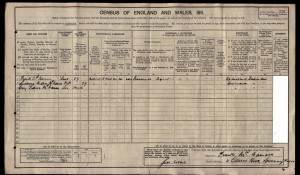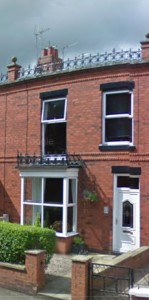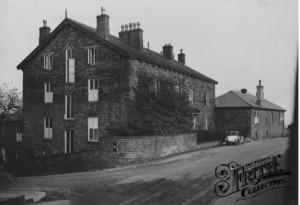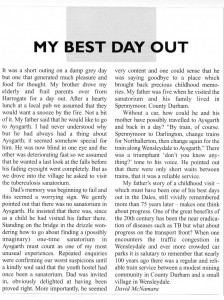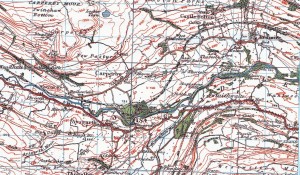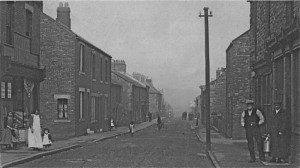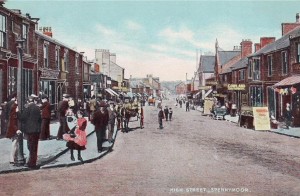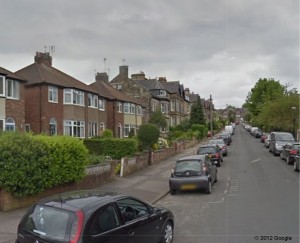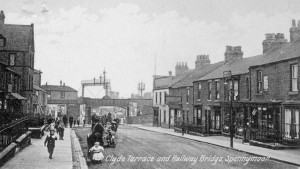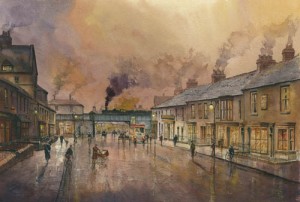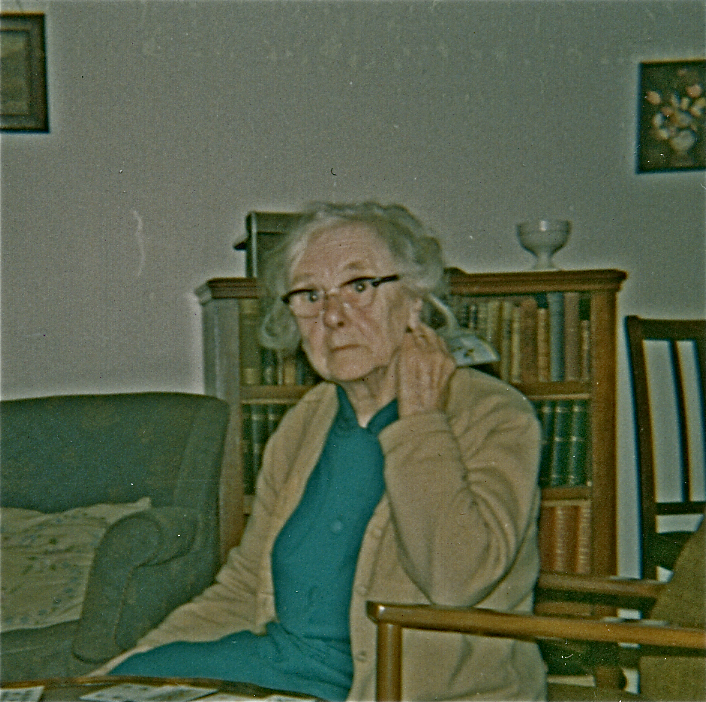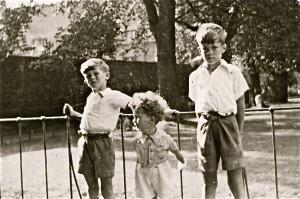Henry McNamara’s Parents
Frank and Susannah McNamara, the Parents of Henry
In this section I bring together the McNamaras and Pearsons and for the sake of clarity there is some overlap with previous sections.
Frank, Dad’s Father
At the time of the 1901 Census Frank was living at 35 Surtees Street, Bishop Aukland with his Mother, Mary Jane McNamara, aged 45, his elder sister, Florence, aged 21, who was working as a waitress in a refreshment rooms and his younger brother, Charles, aged 11. Frank was working as a sawyer’s laborer, see the Census extract below. This is included in part to illustrate the sort of problem one can have with census forms. All the McNamaras are coded as ‘McNamard’, Florence’s occupation is difficult to decipher, the ‘J’ in Mary’s name is coded as ‘I’ and Mary’s place of birth is given as Yorks Mossley when it may have been Lancs Mossley, however, it is the correct record.
Frank was married in 1909 at Aukland, Durham within the Registration Quarter for July August September. He married Susannah Wilkin (also recorded as Wilkins) Pearson who is listed on the same page of the Register.
It is very difficult to trace Frank’s siblings. The girls probably moved home and married and changed their surnames or went into service. The name McNamara and the typical McNamara Christian names from that time were so common in the Lancashire, Fylde and Durham regions that identifying a person as correctly linked to our family is difficult. It is probable, but not certain, that Florence married Samuel Evans, 31, at Aukland in 1914. He was a colliery brakeman. I cannot trace what happened to Charles but there is one record which suggests that he may have died in his 20s.
During their time in Bishop Aukland Frank’s family moved house at least three times. It is not possible to say why. However, the three Bishop Aukland addresses for the family are interesting. The are all situated in the same locality and are within 200 yards of each other, see map below.
The three houses are still standing although they have been modernised. Pictures from Google Street View indicates that they are all similar types of property, namely modest Victorian terrace houses. From the condition of the properties today it does not appear that the moves were made to more spacious or ‘better’ properties. On the face of it they seem to have moved at least three time to a similar type of house, see below (the reason why pictures of the streets are shown rather than specific houses is because I think that house numbers have been changed at some time in the past). The only indication of the family moving to a ‘better’ home is that the Durham Street houses have bay windows. Maybe they had to move because there were limited rental periods. It seems very unlikely that they owned the properties.
However, it is interesting to examine the occupations recorded on the censuses of the families living in the five houses each side the three properties. It must be remembered that Frank’s family were living at Surtees Street and Durham Street after his father had left the family and started a new life in South Africa.
The occupations recorded on the census of the families living in the five houses each side of No 35 Surtees Street were: printer’s compositor, clerk at waterworks, butcher’s apprentice, police constable, brewer’s traveller, two joiners, railway plate laborer, domestic housemaid, grocer’s traveller, general servant, cabinet maker, commercial traveller, insurance agent, store laborer, photographer’s agent, travel maker (?), retired coal miner. And the neighbors adjoining No 154 Durham Street included: plasterer, dressmaker’s assistant, dressmaker, cashier, two school mistresses, clerk at flour mill, warehouse man, postman, baking powder packer, backing powder mixer, painter, housemaid, colliery brakeman, painter’s apprentice, two boot makers, stationery engine man, grocer’s assistant, tailor, tailor’s apprentice, grocer, and apartment landlord. The Surtees Street households are probably smaller than those in Durham Street but there is a similar mix of manual and non-manual occupations. Thus it would be difficult to claim that Frank’s mother and siblings had moved to a ‘better’ neighborhood.
However, the occupations of the people living at the five houses either side of the Edward Street address, when the father was still at home, include: saddle journeyman, lodging house keeper, theatrical manager, boarding house keeper, bookbinder, former schoolmistress, boot finisher, former farmer, printer, milk seller, domestic servant, errand boy and girl, former dressmaker, iron foundry man, laborer, contractor (employing 12 men and 2 boys), agent ins comp, tailor and clothier, iron plate roller (employing 5 men). There is a markedly greater proportion of people in non-manual occupations living at Edward Street. And moreover, there are more people living in the households suggesting that the properties were larger than those in Surtees Street and Durham Street. Thus it seem probable that when Francis, the black sheep of the family, disappeared this had an effect upon the family and they had to move to more modest homes in a poorer neighborhood.
Susannah, Dad’s Mother
In 1901 Susannah was still living with her parents but they had moved to 57 Durham Road, Tudhoe. She was a milliner apprentice and classified as a worker. Mary was no longer living with them.
The occupations recorded on the 1901 Census of the families living in the five houses each side of No 57 Durham Road were: steam engine fitter, colliery clerk, grocer’s assistant, company accountant, machine co clerk, apprentice cabinet maker, retired coal miner, certificated teacher, two pupil teachers (elementary school), dressmaker, clerk in holy orders (boarder), stock taker’s clerk, apprentice engineer, laborer in coke yard, tailor, boiler fireman, draper’s assistant, and fireman moulder. This suggests that both Frank and Susannah came from similar communities and social backgrounds.
As recorded above, Susannah married Frank McNamara in 1909 in Aukland and gave birth to their son, Henry Pearson, father of David, Frank, Ian, and Hugh, at the beginning of November 1910.
The 1911 Census records the young family as living at 11 Osborne Road, Spennymoor. Frank McNamara is listed as an insurance agent. For a copy of the Census page see, below. Presumably he has taken on the business developed by his father in law, Henry Pearson, who had died in 1909.
Some time after his marriage Frank was diagnosed with TB. When exactly is unknown but there is a letter from Frank to his son, Henry, dated August 5, 1915 and addressed from, Aysgarth, for a copy see below.
He was living at the Wensleydale Sanatorium for early cases of tuberculosis. This building later became the local Youth Hostel.He was also asthmatic for most of his life. Thus he must have been suffering from TB six years after his marriage and when Henry was only five years old. The Aysgarth Sanatorium was opened in 1907 and continued until 1947. According to the 1911 Census there were 31 patients and 10 staff.
Once in the late 1990s when we were staying at Askrigg in Wensleydale the parents drove over from Harrogate and we took Dad to visit the Youth Hostel which had been the Aysgarth TB Sanatorium, see an account of the visit written for the Dalesman, below. We asked the Warden if we could have a look around and Dad was obviously delighted with the visit and recognised it as the place were his father had been a patient.
To day it seems remarkable that 100 years ago it was possible to travel by train from Spennymoor to Aysgarth but the map below shows the line existing in the 19th C. The sanatorium is marked on the OS map just under the church at Aysgarth and within close walking distance of the railway station.
Perversely for a tubercular patient and asthmatic, Frank was a keen pipe smoker. A lifelong habit continued by his son, Henry. There is a family tale that Nana was anxious for Frank to give up smoking and promised him that if he gave up smoking for a year she would make a substantial donation to charity. This he agreed to do. Then at lunch time exactly one year later he took his pipe from his pocket and calmly started smoking again, testifying to the McNamaras’ bloody mindedness.
The only other documented information that I can find about Dad’s parents is that in 1921 Frank McNamara was recorded in the Kellys Directory as still living at 11 Osborne Road, Spennymoor. He was listed as an insurance agent. Presumably he must have continued running his insurance business for some years while suffering from TB. I think that there came a time when his wife had to take over the work. The picture gallery on the Spennymoor web site suggests that it may have been a good place to escape from, see here.
I do not know when but sometime his widow, Susannah, moved to West Cliffe Grove, Harrogate, and lived there for the rest of her life. The move will have taken place after Dad qualified because as a medical student he used to commute by train from Bishop Aukland to the Newcastle Medical School every day.
Susannah died at Bulmer, Yorkshire in 1974.
A Comment
Strangely this is all the concrete information that I have about the paternal grandparents of David, Frank, Ian and Hugh. There is certainly more information on the maternal side.
When I think how much information our grandchildren have about us and our families and how much knowledge our children have of their grandparents it is strange that we know so little about the lives and circumstances of our paternal grandparents. Frank, of course, died in 1942 during the War. Nana was no doubt a dominant personality who exercised considerable influence on her son and daughter in law. When we were children she seemed, to me at least, a somewhat distant figure who must be deferred to. Before any visit we were always treated to a preemptive telling off to ensure that we behaved correctly in her presence. I think that she would have preferred it if we had only talked when spoken to – she certainly mentioned so on more than one occasion.

